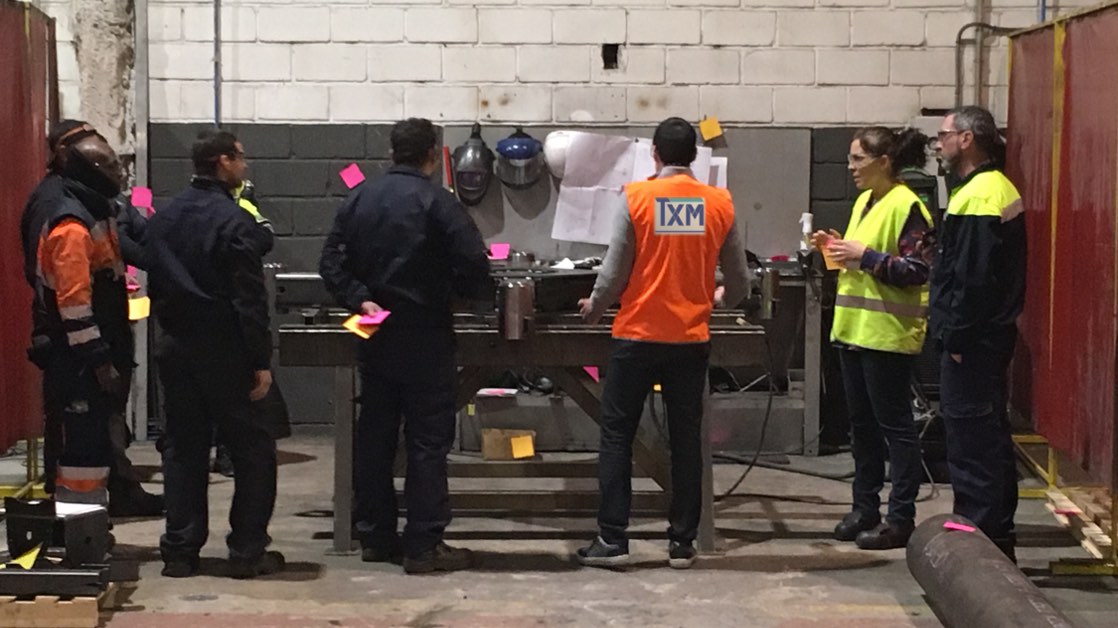Adapted from the Article by TXM Managing Director, Tim McLean in Australian Manufacturing Technology Magazine August Edition

In some countries, including Australia, this training receives generous subsidies and government accreditation. In Australia, for example, hundreds of millions of dollars have been spent funding tens of thousands of manufacturing employees to complete Certificate and Diploma courses in Competitive Manufacturing (the training terminology for a lean manufacturing tools program).
I have personally visited dozens of companies where their leadership and, in many cases, all their employees have completed these qualifications. While in every case the courses have delivered skills and knowledge that meet the formal requirements of the qualification, I have seen very few examples of this training lead to actual lasting change in the workplace.
In fact in many cases the companies I talk to are very frustrated to find that after training all their people that their business is no “Leaner” than before the training. I have had similar experiences in China and South East Asia where I have visited plants where many thousands of dollars have been spent on Black Belt and Green Belt lean manufacturing training for no business result.
You may well say, “so what”, training employees should be good for their morale. If the training is fully government-funded there is no cost and in fact, in many cases, the funding will exceed the training cost. Surely putting everyone through a lean course can do no harm. Well perhaps, but the training is most certainly not “free”.
Let’s say a workforce of 200 people is trained in lean. Typical Lean courses may last 12 months and usually involve around 4-8 hours per week of involvement by the trainees. Taking the lower figure that represents around 38000 hours of staff time. At an average labour cost including on-costs of $20 per hour that represents a cost of $768,000. Therefore, when the training course does not lead to measurable financial benefits you would be entitled to be a bit frustrated.
There are two main reasons for this frustration and apparent lack of success. The first is that unfortunately some of the training on offer is of poor quality. It is quite easy and cheap to hire trainers capable of delivering a structured lean course and assess the participants against a predefined set of competencies. Unfortunately, these trainers often don’t have the knowledge and facilitation skills to coach the trainees through real change in the workplace.
This takes a deep understanding of both lean thinking and manufacturing processes and the ability to manage an improvement team through challenging change. As a result, many of the “projects” associated with training are superficial and lack real impact. However, there are also some very good training companies with very good and experienced trainers and they still have mixed success in achieving lasting change.
The other major factor in companies’ disappointment with lean training is incorrect expectations on the part of the company themselves. The purpose of a training course is to impart knowledge and skills into employees. Success in training is defined by the trainees attaining a satisfactory level of competency in each of the modules that make up the course. Instead, many companies incorrectly believe (often encouraged by entrepreneurial training providers) that the training course will make their business “lean”. This is almost never the case.
So How Do I Make My Business Lean?
Achieving real change in your business is dependent on three factors:
- Leadership: Ensuring that the goals of the lean manufacturing program align with the business strategy, is fully understood and supported by leaders at each level and that there is a process for deploying this lean strategy through the organisation
- Culture: Developing the mindset and everyday leadership behaviours that will support lean implementation. This is particularly important for front line leaders such as team leaders and supervisors who are often the most influential individuals on an organisation’s culture.
- Know-how: This is where the training comes in to provide knowledge in the tools and techniques of lean manufacturing in your organisation.
Providing good quality lean manufacturing training will provide your team with the tools and techniques to apply lean, but they will not be successful in implementing these unless the change forms part of the overall strategic direction of the organisation and is supported by all levels of management. People respond to the needs of their manager, so unless progress in lean implementation is an integral part of a team and individual goals and objectives and subject to regular management review, it will not be regarded as important and will not progress.
Likewise, it is important to understand and address the mindset and cultural issues that impact lean. People follow leaders, so if the leader does not demonstrate behaviours consistent with lean, it is unlikely that anyone will do so. For example, I was working with a client a couple of years ago to establish “first in first out flow” (FIFO) to control WIP between two processes. During the workshop, the Production Manager disappeared.
When he reappeared it was to move a job that was previously at the back of the FIFO queue and put to the front. Regardless of his reasons, this immediately sent the message that the business was not serious about FIFO. As Lean Coaches at this customer we needed to work with this individual and other key leaders to get them to understand why always pushing jobs to the front of the queue did not reduce overall lead times and customer service and created a lot of “non-value added” work and cost.
So How Should We Go About Implementing Lean Manufacturing?
The first thing to realise is that Lean is not a business strategy; it is a management system that enables businesses to execute management strategy effectively. It is therefore important that any improvement process starts with a strategic goal or goals. You need to be very clear why you need to implement lean.
Define specific outcomes that the business needs to achieve such as reducing costs, increasing agility or improving quality and delivery in order to better serve the needs of customers and satisfy shareholders. At TXM we would then usually start the lean implementation with a Senior Leadership workshop to ensure that the Senior Leaders are aligned on these goals, have a common understanding of what lean is and understand their roles in the lean implementation.
The next step is to roll this strategic direction out through the organisation. We would therefore coach the business leaders in Lean Strategy Deployment and the use of A3 one-page-plans to communicate the strategy through each level of the organisation. You then need to get a “lean” understanding of your key business processes. This is done using a value stream map. This provides a current state view of the value and waste in your processes and enables you to work out a future state for these processes which will provide the desired improvements.
An action plan is developed (usually in an A3 format) outlining the steps needed to get to the future state. Usually implementing the future state will involve introducing lean tools such as flow cells, FIFO, load levelling, kanban and set up time reduction. Many of these tools are complex to implement and need to be adapted to the particular purpose where they are to be used. Therefore learning of these tools needs to be specific to the application and provided by coaching the individuals who will be directly involved rather than being delivered to everyone as a generic competency within a training course.
Addressing culture needs to start with the leaders in the organisation, especially front line leaders. At TXM we use a process called the Lean Daily Leadership Process ® (LDLP) which is aimed at giving front line leaders the skills and everyday behaviours to support a lean organisation. This includes developing daily routine tasks for leaders, introducing work cell metrics and coaching on running daily “stand up” meetings with their teams to review performance and solve problems.
Finally, to sustain your lean production system, you need a level of basic lean skills across your organisation. These are the foundations of the Toyota Production System “house” that is often presented. This includes Standard Work, 5s, Daily Problem Solving (we call it SPED® at TXM) and Total Productive Maintenance (TPM). These tools provide a stable operating environment to enable your lean “just in time” processes to operate effectively and reliably. This is where lean training comes into its own, in providing the lean foundation skills across your organisation to support your lean implementation, which in turn is aimed at achieving specific strategic goals.
So does lean training have a role? Our answer is yes, but only in complementing an improvement process driven by business strategy. We recommend using lean approaches to address your key business issues first. This will lead to direct business benefits and build support for the lean-approach. If you are a Small and Medium-Sized Manufacturer, a good place to start is an Enterprise Connect business review. This can help you clarify your top priority business issues and then provide you with funding for targeted assistance to use lean to address those top-priority strategic issues.
Good quality Lean training can then be used to help lock in that improvement by developing your leaders and teams and giving them the skills to sustain and build on the initial improvement. After that, with all levels of the organisation aligned from Senior Management to the front line, a demonstrated track record of lean success and the skills to sustain further improvement, your business can look forward to that elusive goal of your own sustainable lean production system.






